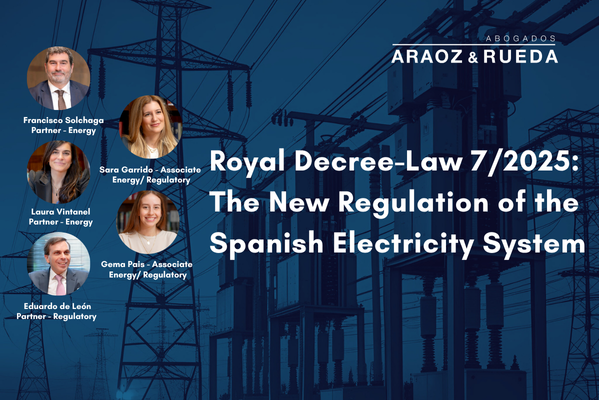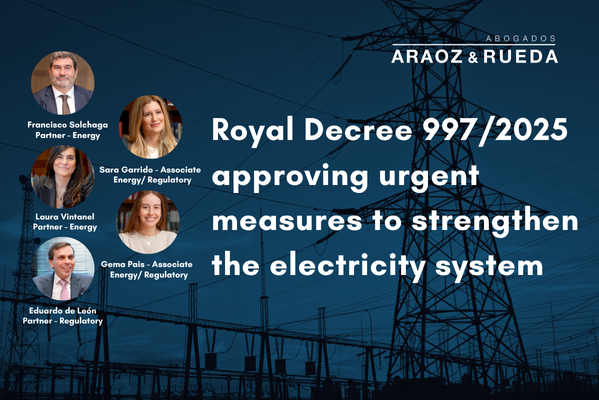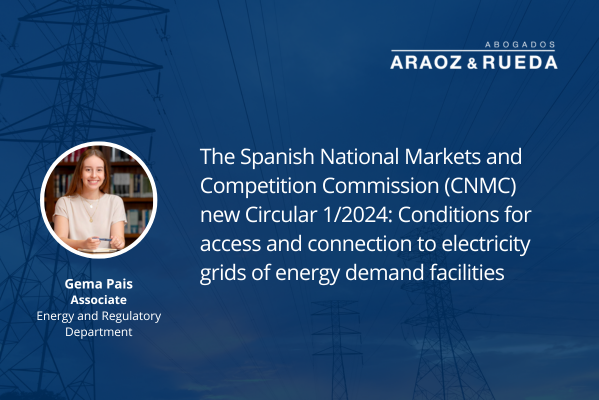1.- INTRODUCTION
Royal Decree-Law 7/2025 (“RDL 7/2025“) addresses the recent blackout of the Spanish electrical system by establishing new, innovative regulations on electricity security. This regulation is structured around several key areas, including: greater control and planning by the National Commission for Markets and Competition (“CNMC”) and Red Eléctrica (“REE“), regulatory reforms planned for the next fifteen months, greater transparency in access to energy data, and the development of a more flexible framework for electricity storage.
One of the main novelties focuses on the promotion of energy storage by extending the designation of a public utility to storage facilities and providing for flexible access permits based on demand needs. In addition, barriers are eliminated for hybrid facilities with storage that consume energy from the grid, these will no longer be considered pure consumers. The law also introduces a new grid hierarchy, prioritizing renewable sources, including hybrid facilities with storage. Lastly, it introduces a new definition of installed capacity for facilities with power park modules and electrochemical storage systems.
Perhaps the most eagerly awaited measure in the renewable energy sector, is the exceptional extension of the fifth milestone for generation facilities that had obtained access and connection permits under very similar terms to Royal Decree-Law 8/2023. This provision also allows permit holders who have already obtained a milestone extension to request an advance or delay of their selected date within the permitted limit of 8 years.
Other significant measures include the introduction of a joint and several liability regime for those who share evacuation infrastructures, the creation of the figure of the self-consumption manager, and the extension of the maximum distance for photovoltaic plants (of up to 5 MW) on industrial roofs from 2 km to 5 km. It also facilitates the grouping of consumers to contract independent aggregators without requiring the consent of the marketer and establishes reinforced system supervision with quarterly reports from the CNMC and triennial inspections.
Finally, the decree promotes electrification by strengthening its strategic planning with mandatory triennial reviews, exempting charging infrastructure under 3,000 kW from requiring authorizations, introducing tax incentives for aerothermal and geothermal installations, and modifies the Horizontal Property Law to facilitate new system installations. Regarding renewable energy, the decree extends exemptions, which no longer obligates production facilities and storage facilities (including those not previously contemplated) from obtaining the AAP[1] and the AAC[2] provided that their installed capacity does not exceed 500 kW.
With all these measures, RDL 7/2025 seeks to create a more resilient, secure, and flexible electricity system, capable of supporting the rapid electrification of the Spanish economy.
2.- MEASURES FOR THE RESILIENCE OF THE ELECTRICITY SYSTEM
Strengthened monitoring and verification of compliance and data transparency
In response to the nationwide electricity blackout on 28 April 2025, the following mandates have been made:
- CNMC: shall prepare (1) a monitoring report on compliance with voltage control obligations by all sector entities subject to such obligations before 25 December 2025. This report shall be updated quarterly and be made publicly available; and (2) an extraordinary inspection plan assessing the restoration capabilities of all entities involved in the restoration process before 25 June 2026. This plan will be periodic, with inspections conducted every 3 years.
- REE: shall submit the results of comprehensive analysis and review to both the CNMC and the Ministry for the Ecological Transition and the Demographic Challenge (“MITECO”). This may include proposals for regulatory modifications, of the following aspects:
| Aspects | Deadline |
| PSS and POD stabilization systems to strengthen system robustness and damping of oscillations | 25/09/2025 |
| New regulation addressing system response to voltage variation rates | 25/12/2026 |
| Requirements for power injection into the grid by production facilities | 25/03/2026 |
| Regulation of adjustment services | 25/06/2026 |
| Proposed operating procedures to coordinate transmission and distribution network development plans | 25/06/2026 |
| Minimum monitoring requirements necessary for incident analysis | 25/09/2026 |
| Definition of a procedure for submitting necessary incident analysis data to REE | 25/09/2026 |
When a regulatory modification proposal is included, it shall be approved —if appropriate —within six months by either the CNMC or the Ministerio para la Transición Ecológica y el Reto Demográfico (“MITECO”).
In addition, to ensure the continuity and security of supply, REE will have a new role: managing the necessary information to serve as a central access point for end-customer data. However, this function will only take place once the ministerial order regulating it has been approved.
Responsibility for shared infrastructures
When, as is often the case, multiple developers or projects (whether generation or storage) share evacuation infrastructure connected to the same position in a SET the following provisions apply:
- Before obtaining the AAP: all parties must submit a signed agreement among all holders outlining the allocation of responsibilities between the different producers and/or storage facility holders. This responsibility can neither be assumed by any other natural or legal person nor exempt any holder from said responsibility.
Failure to submit the agreement will result in responsibilities being distributed proportionally based on the access capacity assigned in the access and connection permits.
- If the AAP has already been obtained: the aforementioned agreement must be submitted within one year. If this is not provided with this period, responsibilities will again be distributed proportionally.
- All holders shall be jointly and severally liable to the electricity system for any event, request, act, or omission related to shared infrastructure provided that the occurrence is directly linked to or caused by such common infrastructures.
Strengthening voltage control and damping against oscillations
- Modification of the Electricity Transmission Network Development Plan 2021-2026: The Plan will incorporate a list of specific actions for voltage control, stability against oscillations, and strengthening the resilience of the electricity system. These actions will be approved by the Council of Ministers and will be carried out (i) without public hearing procedure, (ii) without the need for reports from the CNMC or the Autonomous Communities, and (iii) may exceed the limits of annual investment.
- The authority to establish remuneration mechanisms for facilities participating in the voltage control adjustment service (also called non-frequency voltage control service) shall rest withProvidthe CNMC.
3.- STORAGE
- Storage facilities are declared to be a public utility.
- Authorization procedures for hybrid storage projects under the supervision of AGE are declared urgent for reasons of public interest, provided they do not require (i) ordinary environmental impact statement (“DIA”) or (ii) declaration of public utility (“DUP”).
- Hybridization of electricity production facilities through the incorporation of electrochemical storage modules:
- Exemption from environmental assessment procedures is granted, provided that (i) the storage is located within the polygon of the original generation project, and (ii) the generation project already has a favourable DIA.
- The AAP and AAC[3] will be processed jointly, in accordance with Royal Decree 1955/2000 of December 1, which regulates activities related to transmission, distribution, commercialization, supply, and the authorization procedures of electrical energy installations, with the following specialities:
- Simplified authorization procedure: Applications must be accompanied by a simplified DIA or an exemption from it.
- The procedure for informing other Public Administrations, as well as the project execution approval process (“Information and Approval Procedure“) are unified, reducing deadlines by half.
- The public information procedure will be conducted simultaneously with the Information and Approval procedure, also reducing deadlines by half.
- Definition of installed capacity for administrative authorization purposes:
- Before 25 June 2026, the Government will issue a Royal Decree modifying the definition of installed capacity for generation and/or storage facilities that must be taken into account for the purposes of issuing AAP, AAC, and AAE[4].
- Until then, if processing has begun but AAE has not yet been obtained, the installed capacity of (a) a facility comprising one or more power park modules and one or more storage modules, or of (b) a facility consisting solely of storage modules connected to the grid via the same inverter or set of inverters, the installed capacity shall be equal to the maximum power of the inverter or shared inverters.
- If one or more power park modules and one or more storage facility share the same transformer, the installed capacity shall be equal to the maximum power of the common transformer, unless the shared inverters have a lower maximum power (in which case the installed capacity shall be equal to the maximum power of the inverter(s)).
- If the facility also includes a synchronous generation module, the installed capacity shall be the sum of the installed capacity of the synchronous generation module and the installed capacity of the power park module.
- The maximum power of an inverter shall be the maximum active power that it is capable of producing in permanent regime.
- Access and connection permits for storage facilities shall be flexible, based on a demand-oriented criteria.
4.- FLEXIBILITY
By ministerial order, and following a report from the CNMC and the Autonomous Communities, MITECO may adopt measures to incentivize improved service to users, enhance energy efficiency, and encourage energy savings. This includes the interruptibility service, whereby large energy consumers commit to reducing their electricity consumption at the request of REE, to ensure the stability of the electricity system, in exchange for remuneration.
The services of aggregation, including the figure of the independent aggregator and their rights and obligations, are regulated. Additionally, it is clarified that a consumer may enter contract an independent aggregator without needing the consent of the marketer with whom they have contracted the supply.
Additionally, self-consumption managers are introduced as system entities, defined as natural or legal persons who represent the interests of consumers engaged in self-consumption, handling the necessary procedures on their behalf.
5.- CAPACITY MECHANISM
By ministerial order, MITECO may establish capacity mechanisms to ensure demand coverage and the value of lost load, as provided for in Regulation (EU) 2019/943 of the European Parliament and the Council.
When necessary for security of supply, and upon justification in a REE report, production and storage facilities (“Temporary emergency facilities”) are exempted from obtaining AAP. These facilities will only be required to obtain AAC and AAE. AACs and AAEs are issued for periods of three years. They are renewable up to two times, with each period being three years. Thus, an AAC and AAE can reach up to nine years of operation.
6.- ELECTRIFICATION
Various measures are envisaged to increase electricity demand by making better use of existing networks. These measures target industrial electrification and energy uses such as mobility and air conditioning.
The first group of measures focuses on (i) making better use of existing grids and improving planning. This includes a review of transmission grid planning within three years of its approval, a biennial obligation to approve amendments to specific aspects of current electricity transmission grid development plans, and a mechanism for planning positions for demand-side supply[5] . Likewise, the Government must approve, within twelve months, a Royal Decree establishing a mechanism for the supply of firm demand through transmission grids with distribution functions[6].
Finally, access permits (and, where applicable, access and connection permits) for the supply of demand facilities (voltage ≥ 1kV) will automatically expire if their holders have not formalised an access contract within a period of five years,[7] for a contracted capacity representing at least 50% of the granted access capacity in the access permit during any supply period, and/or said contract is not maintained for a period of three years. The access permit will, also, automatically expire for the part of the capacity granted for which no access contract has been concluded.
The measures aimed at (ii) industrial electrification include the reactivation of the support mechanism to guarantee the competitiveness of the electro-intensive industry (allowing for an eighty percent reduction in the electricity bill corresponding to tolls). This support is effect from 23 January to 31 December 2025 and a modification of the regulations governing the Tax on Economic Activities (“IAE”) when determining installed capacity.
In addition, with the aim of giving new signs of electrification to consumers and industry, new types of self-consumption are established. As a novelty, a consumer may be simultaneously associated with two types of self-consumption: individual self-consumption without surpluses and self-consumption by means of nearby installations and associated through the grid[8].
The measures aimed at (iii) electric mobility lighten the authorisation regime for the electrical infrastructure of electric vehicle charging stations with a capacity of more than 3,000 kW, by subjecting this regime only to those installations that require a DUP or environmental impact assessment.
For their part, the measures dedicated to (iv) electrification of air conditioning modify the Horizontal Property Law to establish a legal framework for decision-making regarding the installation of systems that utilize solar or ambient energy for thermal or electrical purposes. Under this new provision, such installations may be approved by a simple majority, specifically one-third of the property owners representing one third of the ownership shares. Additionally, local entities are granted the authority to regulate rebates in the Construction, Installations, and Works Tax (“ICIO”) and in the Property Tax (“IBI“) to encourage the installation of these systems.
Regarding (v) repowering[9], the processing periods, both substantive and environmental, for procedures initiated after 25 June 2025 are reduced by half in cases where the repowering involves less than a twenty-five percent increase in the originally installed capacity, and the administrative authorisations and environmental impact assessments are requested[10].
The technological evolution of renewable energies has allowed these sources to form a set of tools ensuring the efficient operation of the electricity system. To integrate these facilities in an orderly manner, a series of measures have been established under the category of (vi) orderly deployment of renewables, under RDL 7/2025, and which merits a more detailed analysis.
7.- ORDERLY DEPLOYMENT OF RENEWABLES. DETAILED ANALYSIS
Provisional operating authorisation for testing
A new requirement is introduced whereby, prior to obtaining the definitive operating permit and at the request of the installation’s licensee, a provisional operating permit for testing must be granted. This provisional authorisation is mandatory for production and storage facilities and optional for other types of facilities. However, this regime excludes production and storage facilities with an installed capacity of less than 500 kW from these regulations.
Therefore, the authorisation process for (i) electricity generation facilities or storage facility modules[11] within existing generation facilities, and (ii) storage facilities and modules, will consist of two phases: (1) a provisional operating authorisation phase for testing, and (2) a definitive operating authorisation phase.
For production facilities, the provisional operating authorisation permit for testing and the definitive operating permit allow for registration in the Administrative Registry of Electricity Production Facilities, initially on a provisional basis and later on a definitive basis, subject to submission of the remaining required documentation.
Administrative milestones
To ensure an orderly deployment of renewables, several amendments to Royal Decree-Law 23/2020, of 23 June, approving energy and other measures for economic reactivation (“RDL 23/2020”) are enacted. These establish compliance deadlines for administrative milestones.
For permits granted for (i) pumped-storage hydroelectric power generation projects and (ii) offshore wind power projects, the deadlines established in Section 1.1 of RDL 23/2020 may be extended upon request of the licensee provided that the the total period of validity of the permits does not exceed twelve years for pumped-storage hydroelectric power projects and nine years for offshore wind power projects.
Suspension of the deadline for meeting administrative milestones
As a new feature is introduced allowing for the suspension of the deadline calculation for complying with the administrative milestones under RDL 23/2020. If prior to the expiry of any milestones, the developer accredits the existence of a precautionary measure suspending the effectiveness of the administrative authorisations granted—arising from: (1) the filing of an administrative or contentious-administrative appeal, or (2) the tacit suspension regulated in Article 117 Section 3 of Law 39/2015, of 1 October, on common administrative procedure of the Public Administrations (“LPAC”)—then the calculation of deadlines will be suspended from the adoption of the suspension until it is lifted.
Exceptional extension of milestones
The deadline to obtain the new provisional operating authorisation for testing is set at five years.
Exceptionally, generation facility owners who have obtained access and connection permits after 27 December 2013 and before25 June 2025, and hold an AAC, may request a deadline extension to meet the milestone for obtaining the provisional operating permit for testing, provided that the total period does not exceed eight years.
The application must be made no later than two months after 25 June 2025 (i.e. before 25 August 2025) or after obtaining the AAC, whichever is the later.
The exceptional extension may also be requested by the owners of generation and storage facilities that have obtained an extension of the milestone under Article 28 of RDL 8/2023, who now wish to advance or delay the selected date, within the permitted limits.
Finally, those installations required to meet the fifth milestone by 25 June 2025 will automatically see this deadline extended to 25 September 2025, inclusive, in addition to the possibility of requesting the aforementioned exceptional extension.
With the exception of the rest of RDL 7/2025, the measures in this section entered into force on 24 June 2025.
Other renewable deployment measures
Additional measures, in this group, include (1) for self-consumption, the maximum distance for a production facility to be considered a close installation through the grid is increased from 2 km to 5 km, and (2) for standard installations under the specific remuneration scheme, a twenty-five percent reduction is applied for the year 2025 to both the number of equivalent minimum operating hours, and the operating threshold, compared to current values.
8.- GUARANTEES
For the purposes of modifying the guarantees submitted, it is established that the demand or storage facility shall be considered not to be the same facility in any of the following cases:
- If its geometric centre is relocated by a distance of more than 10 km;
- If there is a change in the CNAE[12] code associated with the facility, provided that this change affects the second level of the CNAE code; or
- If there is a reduction in demand access capacity, provided that this represents a reduction of more than fifty percent of the access capacity originally requested and granted.
FOOTNOTES
[1] AAP refers to “prior administrative authorization”.
[2] AAC stands for “administrative construction authorization”.
[3] AAC refers to “administrative construction authorization”.
[4] AAE refers to “administrative operating authorization”.
[5] From 1 October 2025, every four months, the system operator will send the Secretary of State for Energy a report containing a list of the transmission grid nodes where it is possible to introduce positions in the transmission grid development plan.
[6] This mechanism for feeding firm demands to be developed by the Government will be applied when (1) there are potential consumers with firm projects that cannot be fed at the same substation exclusively because it cannot be expanded, (2) there are one or several transmission positions through which a consumer is already connected or with access and connection permits granted and the consumer is willing to accept a topological change that allows feeding other consumers, and (3) there is a distributor that, making use of the mechanism provided in article 34.2 of Law 24/2013, of 26 December, on the Electricity Sector, develops a network that allows the supply of the aforementioned consumers.
[7] The 5-year period will be calculated from the granting of the access permit. However, the Single Transitional Provision establishes that for access and connection permits granted prior to 25 June 2025 to demand-side installations whose connection point has a voltage between 1 kV and 36 kV, the 5-year period will be calculated from 25 June 2025.
[8] For example, individual self-consumption without surplus may be the self-consumption of an industrial facility, and self-consumption by means of nearby facilities associated through the grid may be, for example, the nearby generation that may exist in the industrial estate or the environment where the industry is located.
[9] Repowering of a production or storage facility is defined as the renovation of such facilities, which may include the total or partial replacement of facilities or operating systems and equipment, with the aim of replacing machines, improving efficiency, increasing the energy produced by the facility, increasing the installed power or with all or several of the above objectives.
[10] If necessary, the environmental impact assessment, simplified environmental impact assessment or other simplified process replacing them shall be limited to the possible impact resulting from a modification or extension of the original project. This applies to the hybridisation of production and storage facilities and to repowering of transmission or distribution network facilities.
[11] Although RDL 7/2025 states “or of modules of generation facilities in existing generation facilities”, we understand that this is a material error, and that in reality the legislator is referring to “or of modules of storage facilities in existing generation facilities”.
[12] CNAE stands for National Classification of Economic Activities.





